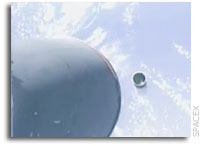SpaceX Demo Flight 2 Flight Review Update

Released by Space Exploration Technologies Corp on June 15, 2007
This document was cleared by DARPA on June 13, 2007. Approved for Public Release, Distribution Unlimited.
Overview
On March 20, 2007 (PST) Space Exploration Technologies (SpaceX) launched Demo Flight 2, the second demonstration flight of the Falcon 1 launch vehicle. The mission was sponsored by the Defense Advanced Research Projects Agency (DARPA) and the US Air Force (USAF). Primary mission objectives were demonstrating responsive launch operations, gathering flight data and retiring technical risk prior to the first operational flight to launch the TacSat-1 spacecraft.
The primary mission objectives for the Demo Flight 2 mission, both programmatic and technical, were met by this return to flight. The vehicle attained a peak altitude of 289 km, 5.1 km/s maximum velocity and remained in the center of the intended ground track throughout flight. An upper stage control anomaly, however, ultimately prevented it from reaching orbital velocity, an important, but secondary mission objective.
This mission also demonstrated a highly autonomous ground control system and rapid recycle from a hot- fire abort to launch in under 70 minutes. On launch day, the first countdown was autonomously aborted by control software at T-0.5 seconds, when it detected that engine chamber pressure was ~0.5% under the designated threshold. After a partial de-tank and re-tank to warm the fuel, the vehicle was launched on the second attempt.
Significant achievements for Demo Flight 2 include successful demonstration of:
- Ground control & support systems, including control software, highly automated operations & autonomous abort
- Rapid response capability – launched within 70 minutes after hot launch abort
- 1st stage performance and control from lift-off through MECO
- Vehicle structural performance & margins through lift-off, transonic & max-Q
- Stage separation
- 2nd stage ignition
- 2nd stage engine performance in vacuum
- Fairing separation
- Guidance, navigation & control performance through T+~475s, including all flight regimes
- Flight software
- Launch & flight environments: thermal, shock & vibration
- Aero-thermal and base-heating (both stages) protection
Although eight anomalies have been identified (described in Section 3) by post-flight data analysis, the upper stage control anomaly was the only known issue that prevented this mission from achieving orbit. Had it not been for the upached its intended orbit:
- Before partial loss of control, the vehicle retained ample performance margin to reach the desired orbit within bounds specified by customer
- Even after partial loss of control, the vehicle continued towards its intended orbit, albeit in a corkscrewing motion around the nominal flight path
- If the instability had not resulted in a roll that moved propellants away from engine inlet, the vehicle retained ample performance margin to reach orbit.








